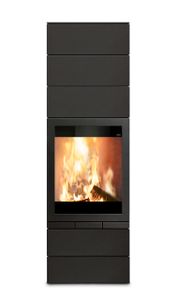Stoves for wood (DE-UZ 212)
Even if it is carried out in a proper manner, heating with wood causes significantly more air pollutant emissions than other energy sources such as heating oil or natural gas. It can result, therefore, in higher levels of particulate matter and polycyclic aromatic hydrocarbon (PAHs) in the air in residential areas – especially if a lot of wood-burning stoves and fireplaces are operated at the same time during colder months in combination with weather conditions causing inversion or if the wood-burning stoves are located in valleys and basins. In particular, manually fuelled log firing systems (log-burning stoves) also emit soot (as a component of the particulate matter). Alongside its negative effect on human health, soot also has a very high global warming potential. Against this background, a reduction in the emissions of particulate matter caused by, amongst other things, the operation of log firing systems is an important environmental goal.
The Blue Angel for stoves aims to encourage innovation in the sector and promote new developments in the design of stoves for the improvement of air quality. This will be achieved using equipment to lower emissions for an efficient and controlled combustion process with a significant reduction in the emission of particulate matter and other flue gases in comparison to conventional stoves.
This includes:
- Separating technologies for reducing air pollutants that are harmful to human health, especially particulate matter and fine particles
- Automatic air regulation that largely avoids any user influence and incorrect use
This will enable the sparing use of wood and reduce the high level of pollutants released into the environment.
To be certified with the Blue Angel, the stoves are subjected to an expanded test process that better reflects the real emissions from burning wood in the stove than is the case in the current type testing process. On this basis, stricter limits for pollutant emissions including the mass of the particulate matter have been defined. Heating appliances holding the Blue Angel must comply with a particle mass concentration limit of 15 mg/m³. The statutory limit according to the 1st BImSchV is 40 mg/m3. This reduction will be achieved above all through the use of innovative technologies such as particle separators.
A large number of ultra-fine particles (smaller than 0.1 µm) are generated when burning wood that are considered to have their own negative impact on human health.
Therefore, the Blue Angel for stoves is for the first time calling for the introduction of a particle count limit for wood-burning stoves in order to protect human health. The suitability of this measurement method has been confirmed in round robin tests carried out as part of a research project and a maximum limit for the particle count in the exhaust gas of 3 million has now been defined in the revised Basic Award Criteria.
The Blue Angel can thus provide guidance to those people who want to purchase a particularly environmentally friendly stove.
-

DROOFF APRICA 2 (TREND / Plus) with catalyst, automatic air regulation fire+ and..
DROOFF Kaminöfen GmbH & Co. KG -

elements 603 Front, Blauer Engel; Kaminofen mit integriertem elektrostatischen..
Skantherm GmbH & Co. KG -

Schiedel KINGFIRE KANTO SC-BE; stove with automatic air regulation "INflame! Fire",..
Schiedel GmbH & Co. KG -

skantherm elements 2.0 K: stove with catalyst, mechanical combustion air regulation and..
Skantherm GmbH & Co. KG -
Benefits to the environment and health
- reduction of particulate matter
- easy to use
-

wodtke samurai iClean / samurai oki iClean; Kaminofen mit HiClean Filtertechnik HCF03..
wodtke GmbH -

xeoos x8 Blue; stove with automatic air regulation and integrated catalyst; versions:..
xeoos GmbH


